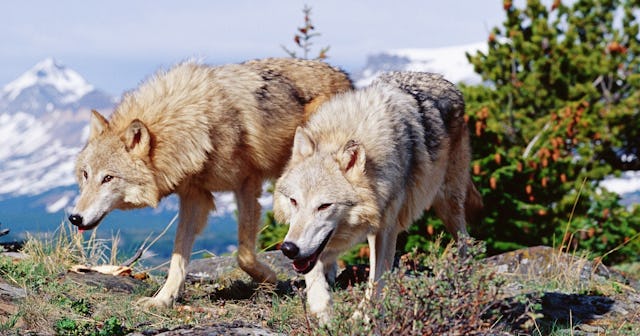11 Wolf Coloring Pages For Your Brave Little Animal Lover

Wolves hold a certain spell over many people all around the world. They’re even so popular that some people look for wolf names for their babies. Nearly every indigenous tribe has a legend involving wolves, with several seeing wolves as gods. Many of these legends revolve around notions of how wolves became domesticated dogs. (PS: We have dog coloring pages, too!) Some legends, though, take people on a more spiritual journey with “the wolf inside.” Across the globe, wolves represent loyalty and guardianship. While you most likely think of wolves and think of the phrase “lone wolf,” the truth about wolves proves wildly different. Wolves are very social and very loyal to their pack. Want to learn even more about these magnificent animals? Keep reading because we created a collection of free wolf coloring pages — and snuck in a ton of interesting facts.
If you have younger children at home, make these pages one of your go-to color activities for toddlers. Children pick up so many developmental benefits while coloring: hand-eye coordination, focus, and self-control. In other words, there’s no downside to letting your kiddos go wild with crayons or colored pencils.
From simple sketches to intricate and unique drawings, these wolf coloring pages and fun facts should speak to wolf-lovers (and coloring fans) of any age. Once finished with these wolf coloring pages, don’t stop the coloring fun there. We’ve collected parrot coloring pages and bee coloring pages, so your little naturalist can continue to explore the animal world. Want to dive deep under the sea? We have dolphin coloring pages and shark coloring pages as well.
Free Printable Wolf Coloring Pages
Wolf No. 1
Think wolves are just wild dogs? Think again! Wolves are rather large. Their paw prints rival that of an adult human hand. Meanwhile, males wolves can measure 6 feet, 5 inches long from (nose) tip to tail. They dwarf even their nearest canine cousin, the husky. A wolf’s hearing works 20 times as well as a human’s. Did you know they don’t particularly like humans and dogs? According to research scientists found that wolves who live near humans and dogs have higher stress levels than wolves who don’t.
Wolf No. 2
Curious what life looks like in a wolf pack? Researchers have studied pack dynamics for decades and found a few intriguing quirks. To start, while wolves choose their mates for life, it’s typically only the leader of the pack (the alpha male) that mates and breeds with his female companion. The other wolves help care for the pups. They can also travel up to 124 miles within a day. And did you know wolves have been recorded in caves in Europe that date back to 20,000 B.C.? (Wolves are ancient!)
Wolf No. 3
This guy looks hungry! But he only gets first dibs on food if he’s the alpha male. Once a lone wolf or pack has hunted down their prey, the alpha male chows down. Once he gets his fill, the rest of the wolves take their turn to eat. Did you know Vikings wore wolf skins and drank wolf’s blood to take on embody a wolf’s spirit before battle? Talk about dedication… And this wolf above may look harmless, but wolves grow about 42 teeth designed to stab and crush bone. Their jaws have a crushing power of 1,500 pounds per square inch!
Wolf No. 4
The alpha male isn’t above paying his dues, though. Among the very social and familial dynamics of a pack, any member is likely to sacrifice themselves for the greater good. That includes the alpha.
Wolf No. 5
A wolf’s main threat to survival is, unfortunately, humans. As we develop land and spread our communities, we diminish their habitats. And while strict rules for hunting wolves now exist, that wasn’t always the case. Historically, humans saw wolves as a threat and subsequently sought to kill them.
Wolf No. 6
How much ground does a wolf cover? An individual pack’s territory is rather far-reaching. For example, of the wolves living in Minnesota, their territories range between 25 to 150 square miles. In Alaska and Canada, the wolf pack territories can be as large as 1000 square miles.
Wolf No. 7
With so much territory, you better be able to get around pretty fast. Wolves can do just that. While sprinting and on the prowl, wolves travel at speeds of roughly 36 miles per hour. When hunting, on the other hand (or should we say paw?), they tend to move at the more leisurely pace of about five miles an hour.
Wolf No. 8
On the subject of hunting, do you know what wolves eat? They typically live off animals like moose, deer, elk, and bison — AKA hoofed mammals, also known as “ungulates.”
Wolf No. 9
How do they get past all that fur on their prey? By using all 42 teeth, of course! Though, it’s their noses that are most impressive. A wolf’s sense of smell is 100 times stronger than ours. So, ya know, wear deodorant. It’s for the wolves.
Wolf No. 10
Wolves also make a ton of noise. They communicate in pretty much the same way as your dog with barks, yips, growls, and, yes, howls. Their howls are distinct between packs and can be heard from around ten miles away!
Wolf No. 11
Wolves feed their pups the same way Mommy birds feed their chicks. They throw up the food they swallowed so their babies can eat it later. And fun fact, wolves have webs between their toes that help them swim.
Click here to print all of the wolf coloring pages at once!
This article was originally published on